Different Factors Affecting Vacant Housing According to Regional Characteristics in South Korea
Abstract
1. Introduction
1.1. The Evolution of the Vacant House Phenomenon
1.2. Literature Review
2. Materials and Methods
2.1. Definition of Vacant Houses
2.2. Research Areas and Methods
2.3. Materials
3. Vacant Houses in South Korea
3.1. Spatial Distribution of Vacant Houses
3.2. Vacant Houses by Housing Type
4. Results
4.1. Cluster Analysis
4.2. Multiple Regression Analysis
5. Discussion and Conclusions
Author Contributions
Funding
Acknowledgments
Conflicts of Interest
References
- Martinez-Fernandez, C.; Audirac, I.; Fol, S.; Cunningham-Sabot, E. Shrinking cities: Urban challenges of globalization. Int. J. Urban Reg. Res. 2012, 36, 213–225. [Google Scholar] [CrossRef] [PubMed]
- Schilling, J.; Logan, J. Greening the rust belt: A green infrastructure model for right sizing America’s shrinking cities. J. Am. Plan. Assoc. 2008, 74, 451–466. [Google Scholar] [CrossRef]
- Park, S.; Byeon, E.; Lee, E.; Yeo, H.; Seong, E. Neighbourhood Regeneration with Empty Homes; Architecture and Urban Research Institute: Sejong, Korea, 2017; ISBN 979-11-5659-159-7. [Google Scholar]
- Mikelbank, B.A. Spatial Analysis of the Impact of Vacant, Abandoned and Foreclosed Properties; Federal Reserve Bank of Cleveland: Cleveland, OH, USA, 2008. [Google Scholar]
- Han, H. The impact of abandoned properties on nearby property values. Hous. Policy Debate 2014, 24, 311–334. [Google Scholar] [CrossRef]
- Kelling, G.L.; Wilson, J.Q. Broken windows. Atl. Mon. 1982, 249, 29–38. [Google Scholar]
- Accordino, J.; Johnson, G.T. Addressing the vacant and abandoned property problem. J. Urban Aff. 2000, 22, 301–315. [Google Scholar] [CrossRef]
- Son, E.; Maeng, H.; Lee, H. The spatio-temporal patterns of the vacant homes clusters and their impact on the neighborhood land price–The case of Busan Metropolitan city. J. Real Estate Anal. 2015, 1, 71–90. [Google Scholar] [CrossRef]
- Cohen, J.R. Abandoned housing: Exploring lessons from Baltimore. Hous. Policy Debate 2001, 12, 415–448. [Google Scholar] [CrossRef]
- Silverman, R.M.; Yin, L.; Patterson, K.L. Dawn of the dead city: An exploratory analysis of vacant addresses in Buffalo, NY 2008–2010. J. Urban Aff. 2013, 35, 131–152. [Google Scholar] [CrossRef]
- Kim, J.; Nam, J. A Study on Vacant House Distribution and Management of Urban Declining Area. J. KRSA 2016, 32, 105–122. [Google Scholar]
- Rhodes, J.; Russo, J. Shrinking ‘Smart’?: Urban Redevelopment and Shrinkage in Youngstown, Ohio. Urban Geogr. 2013, 34, 305–326. [Google Scholar] [CrossRef]
- Schilling, J.M. The Revitalization of Vacant Properties: Where Broken Windows Meet Smart Growth; ICMA (International City/County Management Association): Washington, DC, USA, 2002. [Google Scholar]
- Nam, J.; Han, J.; Lee, C. Factors Contributing to Residential Vacancy and Some Approaches to Management in Gyeonggi Prevince, Korea. Sustainability 2016, 8, 367. [Google Scholar] [CrossRef]
- Population and Housing Census, Statistics Korea. Available online: http://www.census.go.kr/ (accessed on 4 August 2019).
- Joh, Y.; Shin, D.; Lee, J.; Lee, D. South Korea 2050 Future Sailing; LX Korea Land and Geospatial Informatix Corporation: Jeonju, Korea, 2016. [Google Scholar]
- Park, S.; Kim, S.; Yoon, J. Policy Implications for Regeneration and Reuse of Empty Homes; Architecture and Urban Research Institute: Sejong, Korea, 2016; ISBN 979-11-5659-093-4. [Google Scholar]
- Nam, J. Making Activity Core for Local Community Utilizing Urban Vacant Space. In Small Research and Small Seoul, 1st ed.; The Seoul Institute: Seoul, Korea, 2012; pp. 15–17. [Google Scholar]
- Lee, C.; Ji, N. A Study on the Utilization of Empty House for Rural Activation in Korea. J. Korean Soc. Rural Plan. 2013, 19, 169–182. [Google Scholar] [CrossRef][Green Version]
- Bassett, E.M.; Schweitzer, J.; Panken, S. Understanding Housing Abandonment and Owner Decision-Making in Flint, Michigan: An Exploratory Analysis; Genesee Institute: Flint, MI, USA, 2006. [Google Scholar]
- Mallach, A. Bringing Buildings Back: From Abandoned Properties to Community Assets; National Housing Institute: Montclair, NJ, USA, 2010. [Google Scholar]
- Immergluck, D. Examining changes in long-term neighborhood housing vacancy during the 2011 to 2014 U.S. national recovery. J. Urban Aff. 2015, 38, 607–622. [Google Scholar] [CrossRef]
- Jeon, Y.; Kim, S. The causes and characteristics of housing abandonment in an inner-city neighborhood—Focused on the Sungui-dong area, Nam-gu, Incheon. J. Urban Des. Inst. Korea Urban Des. 2016, 17, 83–100. [Google Scholar]
- Park, J.; Oh, S. Spatial Pattern and Causative Factor Analysis of Vacant Housing in Daegu, South Korea Using Individual-level Building DB. J. Korean Reg. Sci. Assoc. 2018, 34, 35–47. [Google Scholar]
- Hillier, A.E.; Culhane, D.P.; Smith, T.E.; Tomlin, C.D. Predicting housing abandonment with the Philadelphia neighborhood information system. J. Urban Aff. 2003, 25, 91–106. [Google Scholar] [CrossRef]
- Morckel, V. Spatial characteristics of housing abandonment. Appl. Geogr. 2014, 48, 8–16. [Google Scholar] [CrossRef]
- Han, S. Spatial Characteristics and the Fixation Process of the Vacant∙Abandoned Properties in Iksan City; Seoul National University: Seoul, Korea, 2016. [Google Scholar]
- Lee, J. Spatial Pattern Analysis of Empty Houses in Rural Areas and Spatial Planning Strategies; Anyang University: Anyang, Korea, 2016. [Google Scholar]
- Lee, J.; Newman, G.; Park, Y. A Comparison of Vacancy Dynamics between Growing and Shrinking Cities Using the Land Transformation Model. Sustainability 2018, 10, 24. [Google Scholar] [CrossRef] [PubMed]
- Morckel, V. Empty Neighborhoods: Using Constructs to Predict the Probability of Housing Abandonment. Hous. Policy Debate 2013, 23, 469–496. [Google Scholar] [CrossRef]
- Ministry of Internal Affairs and Communications of Japan 2014. Summary of the Law for Special Measures to Promote Dealing with Vacant Houses, etc. Available online: http://www.mlit.go.jp/common/001080534.pdf (accessed on 4 November 2019).
- Department for Communities and Local Government. Available online: https://assets.publishing.service.gov.uk/government/uploads/system/uploads/attachment_data/file/357791/140923-CTIL_on_EHP.pdf (accessed on 4 November 2019).
- Korea Ministry of Government Legislation. Available online: http://www.moleg.go.kr (accessed on 5 September 2019).
- Autonomous Law Information System. Available online: http://www.elis.go.kr/ (accessed on 5 September 2019).
- Song, M.; Jang, H. Characterization of Cities in Seoul Metropolitan Area by Cluster Analysis. J. Korean Soc. Geospat. Inf. Sci. 2010, 18, 83–88. [Google Scholar]
- Urban Regeneration Information System. Available online: http://www.city.go.kr/index.do (accessed on 4 November 2019).
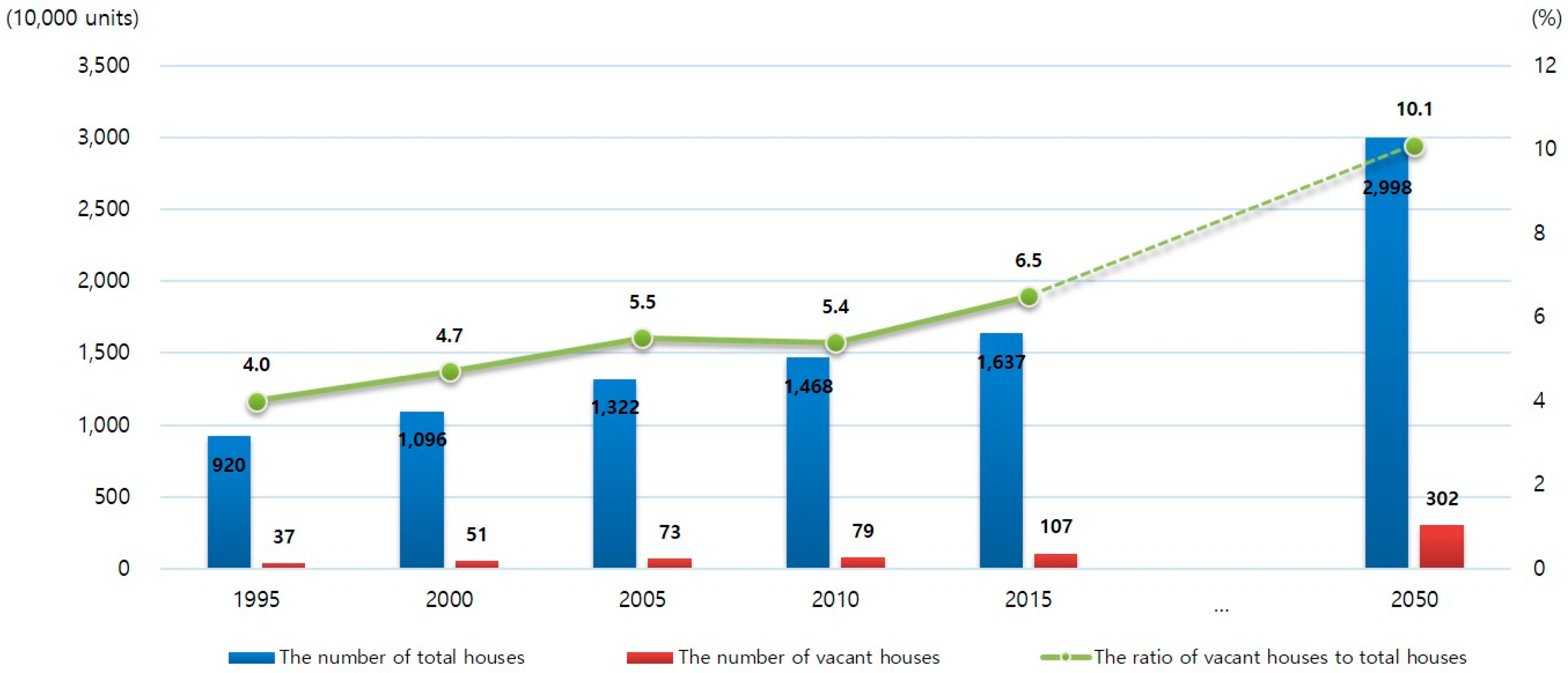
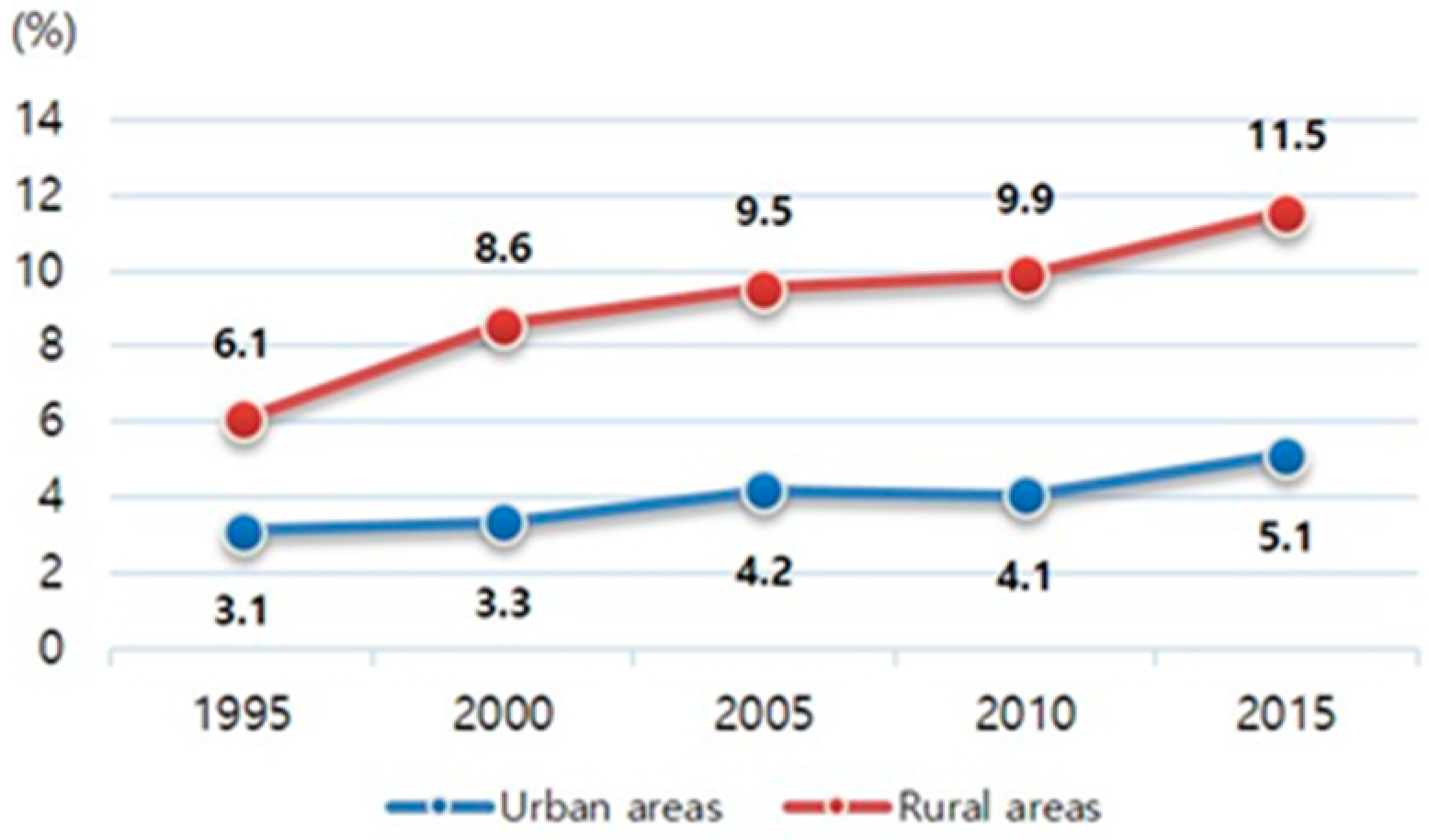
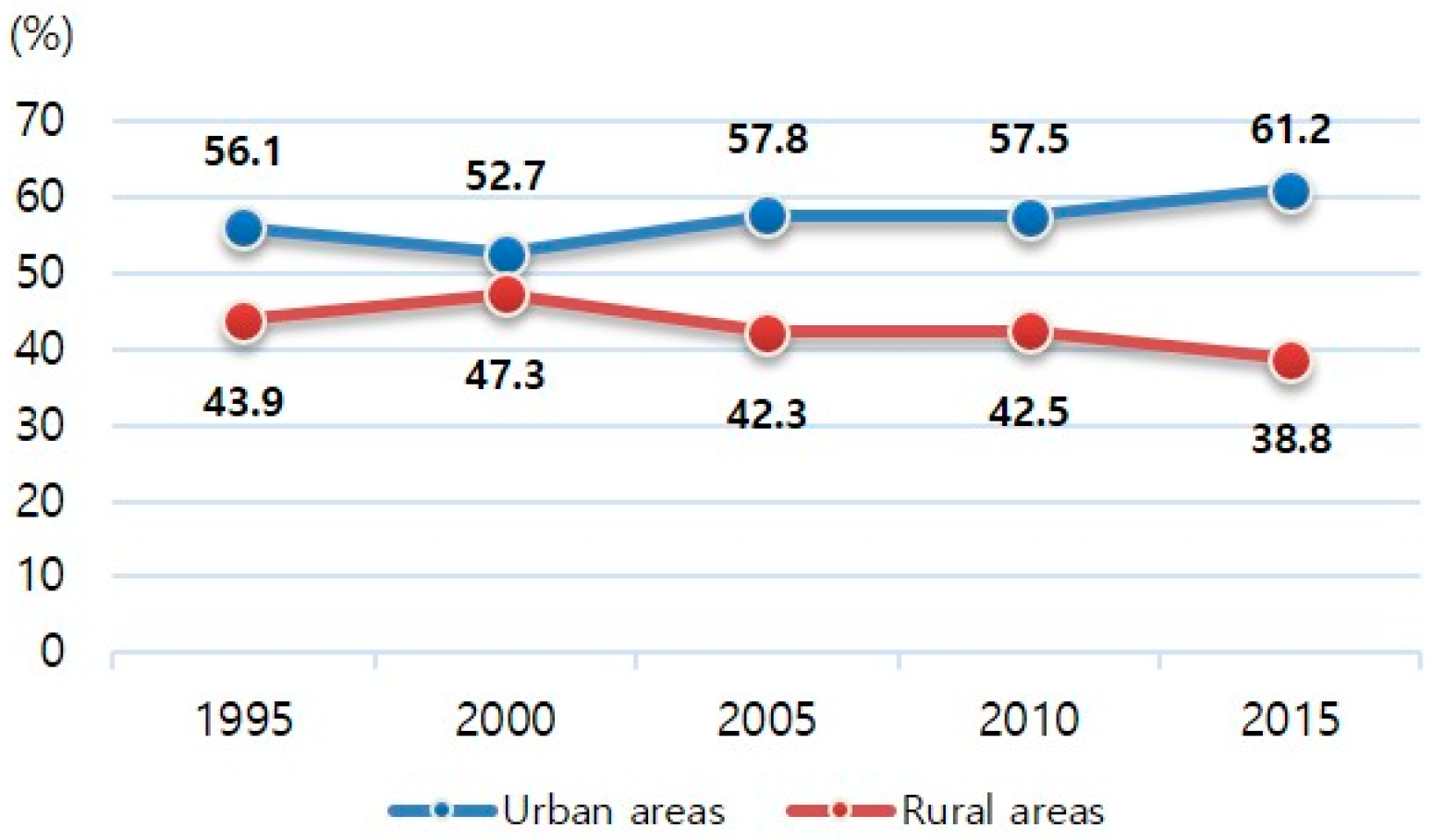
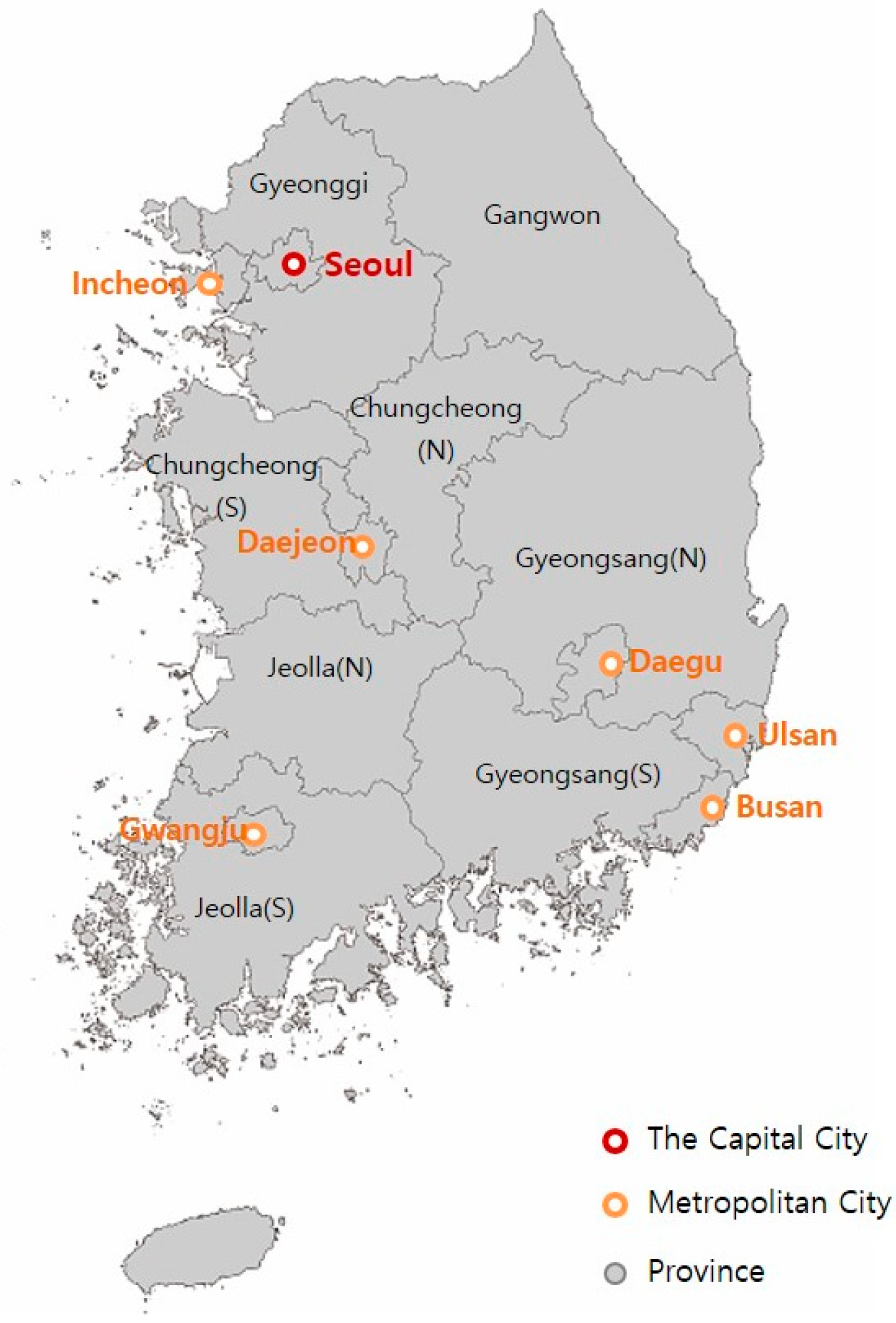
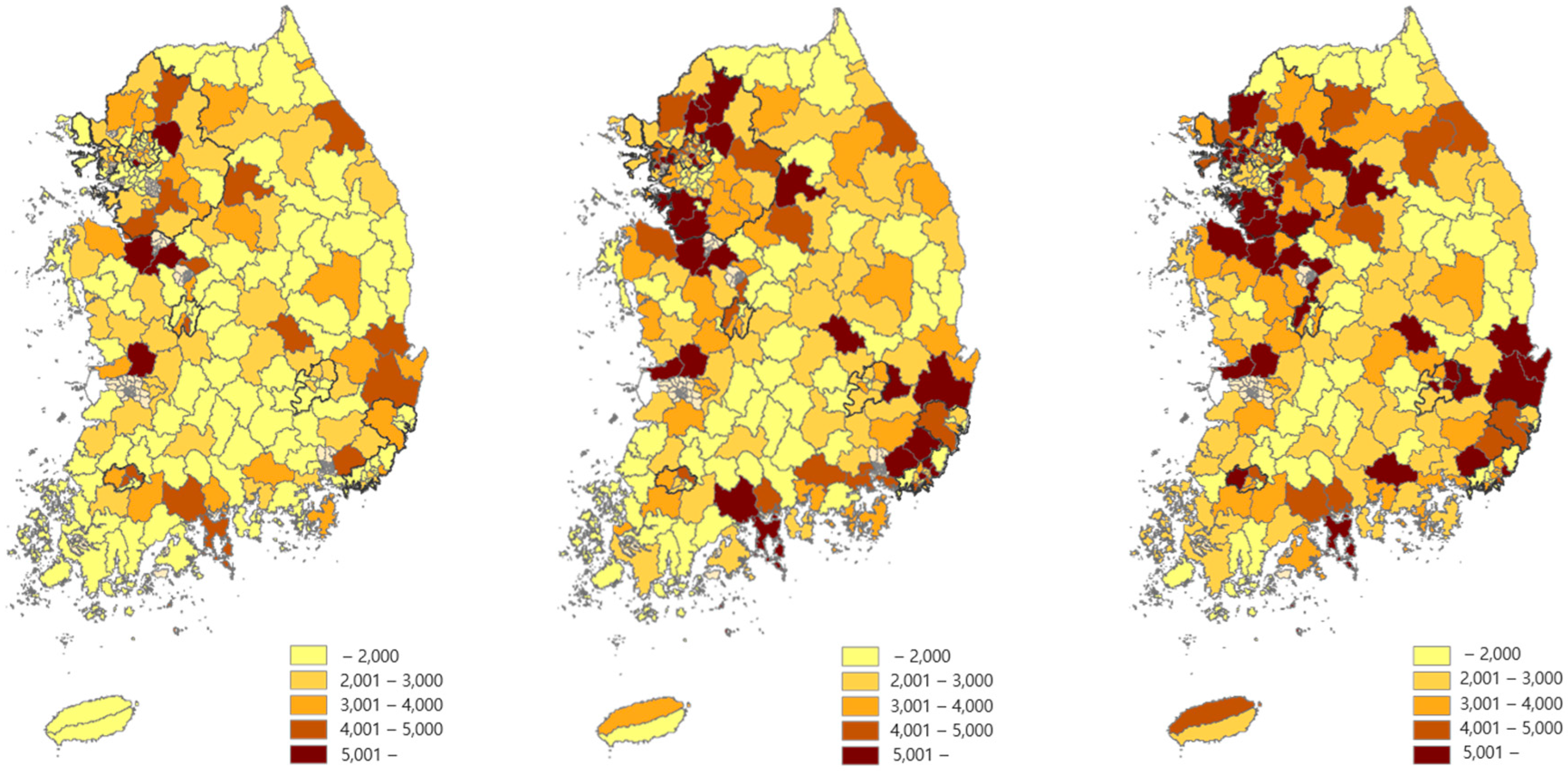


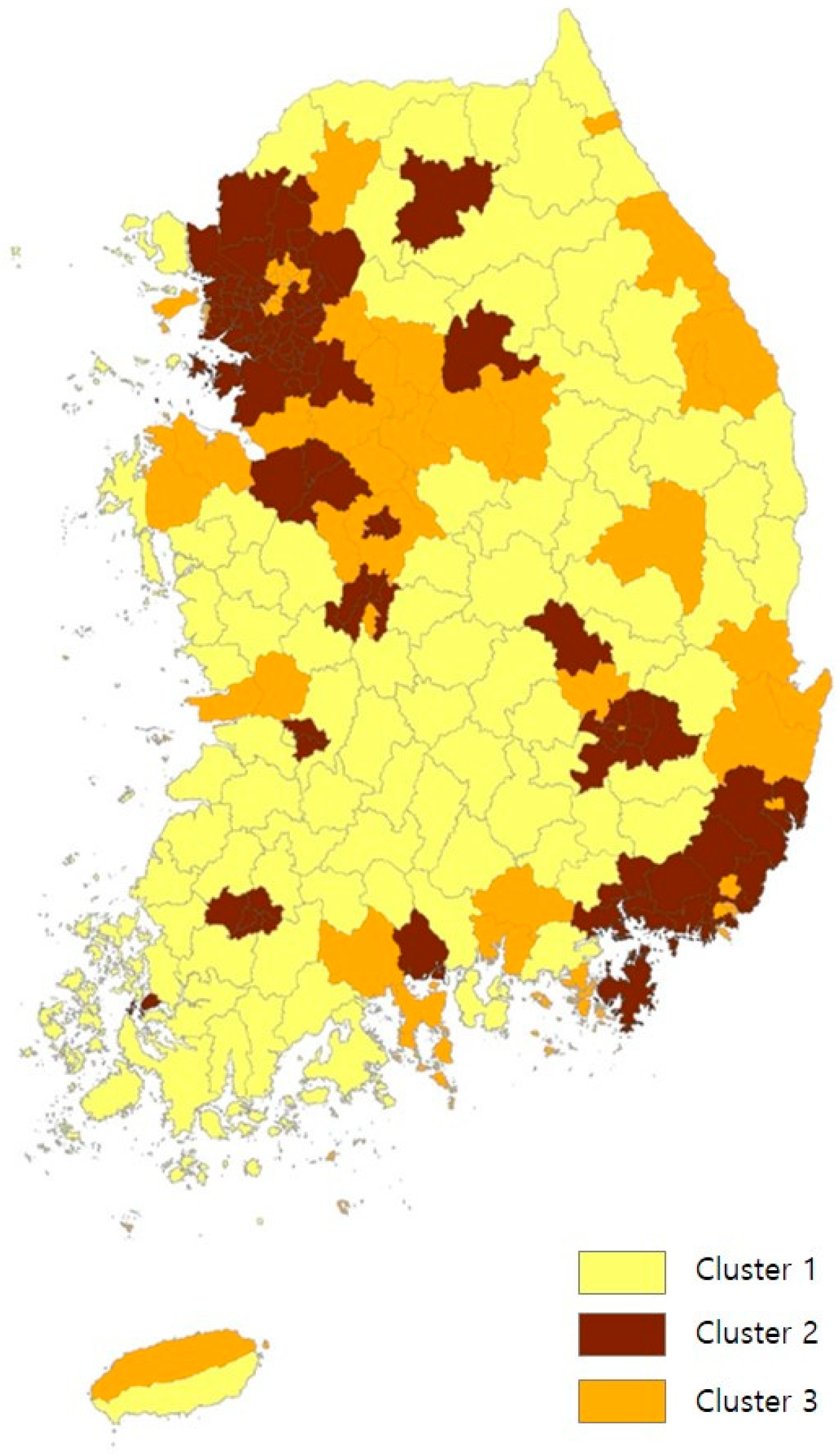
| Variables | Formula | ||
|---|---|---|---|
| Dependent Variable | Ratio of vacant houses | Number of vacant houses/total number of houses × 100 | |
| Independent Variable | Socioeconomic factors | Ratio of elderly population | Number of people aged 65 and older/total population × 100 |
| Population change rate (2005–2010) | (Number of population in 2010-number of population in 2005)/number of population in 2005 × 100 | ||
| Ratio of national basic livelihood security recipients | Number of recipients of national basic living security/number of resident-registered population × 100 | ||
| Employment rate | Number of employed population/number of people aged 15 to 65 × 100 | ||
| Rate of change for businesses (2007–2010) | (Number of businesses * in 2010-number of businesses in 2007)/number of businesses in 2007 × 100 | ||
| Real estate market factors | Rate of owner-occupied dwellings | Number of households living in one’s own house/total household × 100 | |
| Distribution ratio of house | Number of total houses/number of resident-registered households × 100 | ||
| Ratio of apartments | Number of apartments/number of total houses × 100 | ||
| Ratio of detached house | Number of detached houses/number of total houses × 100 | ||
| Ratio of new housing | Number of houses built in 2010/total number of house × 100 | ||
| Physical factors | Ratio of aged housing | Number of houses more than 30 years/total number of houses × 100 | |
| Total Housing | Vacant Housing | Ratio of Vacant Housing * | |||
|---|---|---|---|---|---|
| Nationwide | 1637 | 100% | 107 | 100% | 6.5% |
| SMA ** | 743 | 45.4% | 27 | 25.4% | 3.7% |
| Non-SMA | 894 | 54.6% | 80 | 74.6% | 8.9% |
| Urban areas | 1277 | 78.0% | 65 | 61.2% | 5.1% |
| Rural areas | 360 | 22.0% | 42 | 38.8% | 11.5% |
| Cluster 1 | Cluster 2 | Cluster 3 | ||
|---|---|---|---|---|
| Ratio of vacant houses | 5.76 | 1.10 | 1.98 | |
| Ratio of elderly population | 27.83 | 8.80 | 13.32 | |
| Population change rate (2005–2010) | −5.65 | 7.48 | −0.89 | |
| Ratio of national basic livelihood security recipients | 9.84 | 4.06 | 6.13 | |
| Employment rate | 61.10 | 54.88 | 54.27 | |
| Rate of change for enterprises * (2007–2010) | −0.08 | 6.07 | 1.08 | |
| Rate of owner-occupied dwellings | 78.34 | 51.86 | 54.13 | |
| Distribution ratio of housing | 105.59 | 83.73 | 83.71 | |
| Ratio of apartments | 17.26 | 71.35 | 48.60 | |
| Ratio of detached houses | 76.43 | 15.75 | 35.70 | |
| Ratio of new housing | 5.40 | 8.40 | 6.13 | |
| Ratio of aged housing | 28.02 | 4.99 | 14.33 | |
| The number of regions | Si | 14 | 37 | 24 |
| Gun | 75 | 3 | 8 | |
| Gu | - | 35 | 34 | |
| Total | 89 | 75 | 66 | |
| Variables | Cluster 1 | Cluster 2 | Cluster 3 | All Cities | |||||
|---|---|---|---|---|---|---|---|---|---|
| Declining City Type | Growing City Type | Stagnant City Type | |||||||
| Coef. | t | Coef. | t | Coef. | t | Coef. | t | ||
| 1 | Ratio of elderly population | 0.16 ** | 2.32 | −0.03 | −0.41 | 0.04 | 0.42 | 0.11 *** | 3.36 |
| Population change rate | −0.02 | −0.51 | 0.01 | 0.61 | −0.01 | −0.42 | −0.03 ** | −2.36 | |
| Ratio of national basic livelihood security recipients | −0.06 | −0.86 | 0.08 | 1.32 | 0.14 | 1.41 | 0.04 | 0.87 | |
| Employment rate | 0.05 | 1.41 | −0.03 | −0.76 | 0.04 | 1.09 | 0.04 * | 1.82 | |
| Rate of change for enterprises | −0.02 | −0.36 | 0.03 | 1.27 | 0.03 | 0.82 | 0.02 | 0.98 | |
| 2 | Rate of owner-occupied dwellings | −0.13 *** | −3.63 | −0.40 ** | −2.62 | −0.03 | −1.41 | −0.06 *** | −4.63 |
| Distribution ratio of housing | 0.24 *** | 7.78 | 0.05 *** | 4.14 | 0.06 *** | 3.32 | 0.10 *** | 9.88 | |
| Ratio of apartments | 0.02 | 0.67 | 0.00 | −0.15 | 0.00 | 0.02 | 0.00 | −0.46 | |
| Ratio of new housing | −0.10 * | −1.27 | −0.01 | −0.66 | 0.08 *** | 2.99 | 0.02 | 1.03 | |
| 3 | Ratio of aged housing | 0.05 | 1.59 | 0.08 *** | 3.09 | 0.06 | 1.61 | 0.05 *** | 2.90 |
| Constant | −17.07 *** | −3.67 | −0.05 | −0.02 | −6.22 ** | −2.59 | −7.47 *** | −5.25 | |
| Adjusted R2 | 0.58 | 0.41 | 0.61 | 0.83 | |||||
| F | 13.15 *** | 6.05 *** | 11.02 *** | 111.81 *** | |||||
| N | 89 | 75 | 66 | 230 | |||||
© 2019 by the authors. Licensee MDPI, Basel, Switzerland. This article is an open access article distributed under the terms and conditions of the Creative Commons Attribution (CC BY) license (http://creativecommons.org/licenses/by/4.0/).
Share and Cite
Yoo, H.; Kwon, Y. Different Factors Affecting Vacant Housing According to Regional Characteristics in South Korea. Sustainability 2019, 11, 6913. https://doi.org/10.3390/su11246913
Yoo H, Kwon Y. Different Factors Affecting Vacant Housing According to Regional Characteristics in South Korea. Sustainability. 2019; 11(24):6913. https://doi.org/10.3390/su11246913
Chicago/Turabian StyleYoo, Hyejeong, and Youngsang Kwon. 2019. "Different Factors Affecting Vacant Housing According to Regional Characteristics in South Korea" Sustainability 11, no. 24: 6913. https://doi.org/10.3390/su11246913
APA StyleYoo, H., & Kwon, Y. (2019). Different Factors Affecting Vacant Housing According to Regional Characteristics in South Korea. Sustainability, 11(24), 6913. https://doi.org/10.3390/su11246913





